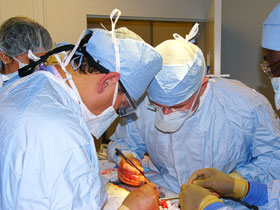  |
| HOME | THIS ISSUE | CALENDAR | GRANTS | BACK ISSUES | < BACK | NEXT > |
New training for trauma surgeons develops skills through simulationby Kristina Goodnough - September 5, 2006 | ||||
| Learning to fly a helicopter more than 20 years ago, trauma surgeon Lenworth Jacobs had a "eureka moment." While manipulating the controls and learning the intricacies of pitch, drag, and thrust in the classroom and in a flight simulator, it came to him: This is the way to teach complex subjects.
"In the airline industry, pilots simulate 100 take-offs and landings before they ever fly a real aircraft," says Jacobs, professor and chairman of the Health Center's Department of Traumatology and Emergency Medicine. "They practice maneuvers of all kinds, so they have the skills and confidence they need when they finally get to fly for real." The inspiration led him to develop a training program for trauma surgeons, which emulates the training program for pilots. Known as the Advanced Trauma Operative Management Course (ATOM), it relies on standardization, simulation, and repetition to ensure competence. "Historically, surgeons trained as apprentices, working with a master surgeon, handing him his instruments and learning from him," says Jacobs. "Even today's internship and residency training is based on the apprenticeship model." That model has been periodically criticized as too variable and unreliable since the publication of the Flexnor Report in 1910, a nationwide evaluation of medical training institutes undertaken for the American Medical Association. With advances in surgical technology and the move in 2003 by the Accreditation Council for Graduate Medical Education to limit residency training hours, the need for a new training model gained ground. "Placing limits on residency hours was an important move for patient safety, but it meant residents had to learn in a shorter period of time," says Jacobs. "Our goal is to standardize surgical education and help ensure trauma surgeons have the competence they need before they ever get to a real patient," he says. As part of the ATOM curriculum, the students are given pre-tests to assess their level of knowledge and confidence regarding the management of patients with penetrating trauma. They are provided with a compact disc or video detailing correct surgical repairs of the injuries, along with a textbook with detailed graphics. During the course, students attend six standardized 30-minute lectures outlining the diagnosis and management of injuries to the organs in the chest and abdomen. They then proceed to a standardized surgical skills laboratory where they perform the repairs on models carefully designed to simulate the human body in size, shape, and feel. Following their work, the students are tested again, and their knowledge and dexterity evaluated. The results are compared with their pre-tests and with other students at different levels of training. "In this country, unless surgeons are working at a big-city hospital or in a trauma unit, treating trauma is a small part of their regular workload," says Jacobs. "But when they see it, they have to be able to handle it. By working on a standardized model in a standardized operating room, students get the same experience they would get in a real operating room with a real patient. "Simulation allows them to practice over and over again, so they have the confidence and skill they need to handle a real situation," he adds. The ATOM course is currently taught to surgical residents and fellows and to practicing surgeons at 13 training sites in the United States, including Hartford Hospital and two in Canada. It is also taught to surgeons in West Africa, at a site in Ghana that Jacobs helped establish last year. After initially training West African surgeons who traveled to the United States, Jacobs and a team of American surgeons traveled twice to Ghana last year to help implement the training program at the Ghana Surgical Skills Training Center at the Korle Bu Hospital in Accra. The work was supported by International Aid, Johnson and Johnson Inc., and by the West African College of Surgeons, which gave Jacobs an honorary fellowship this year in recognition of his work bringing the ATOM course to West Africa. "So far, we have trained 520 surgeons through the course, and have trained more than 100 instructors," says Jacobs, who was recently named to the Education Committee of the American College of Surgeons. "It's a good start."
|
| ADVANCE HOME UCONN HOME |

